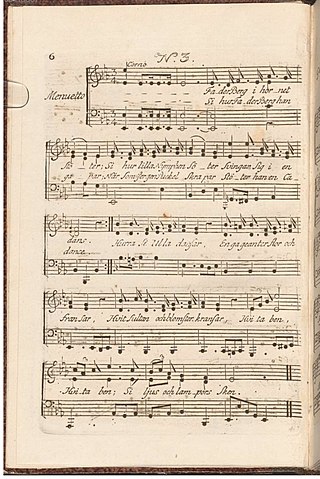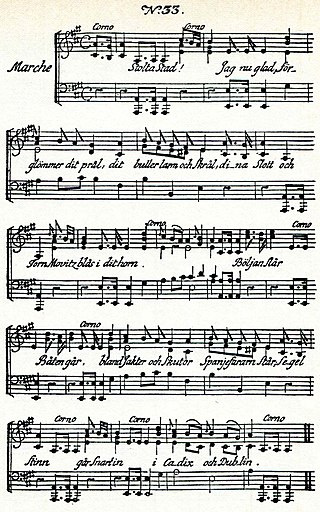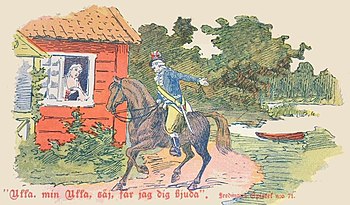Maria Kristina Kiellström, known as Maja Stina, was a Swedish silk worker and alleged prostitute, and most famously the fictional demimonde prostitute or Rococo "nymph" Ulla Winblad in the songs called Fredman's Epistles by Sweden's troubadour, Carl Michael Bellman, who made her a major character in his work.

Fredmans epistlar is a collection of 82 poems set to music by Carl Michael Bellman, a major figure in Swedish 18th century song. Though first published in 1790, it was created over a period of twenty years from 1768 onwards. A companion volume, Fredmans sånger was published the following year.

Solen glimmar blank och trind is Epistle No. 48 in the Swedish poet and performer Carl Michael Bellman's 1790 song collection, Fredman's Epistles. The Epistle is subtitled "Hvaruti afmålas Ulla Winblads hemresa från Hessingen i Mälaren en sommarmorgon 1769". One of his best-known and best-loved works, it depicts an early morning on Lake Mälaren, as the Rococo muse Ulla Winblad sails back home to Stockholm after a night spent partying on the lake. The composition is one of Bellman's two Bacchanalian lake-journeys, along with epistle 25, representing a venture into a social realism style.

Ulla! min Ulla! säj, får jag dig bjuda, is one of the Swedish poet and performer Carl Michael Bellman's best-known and best-loved songs, from his 1790 collection, Fredman's Epistles, where it is No. 71. A pastorale, it depicts the Rococo muse Ulla Winblad, as the narrator offers her "reddest strawberries in milk and wine" in the Djurgården countryside north of Stockholm.

Hvila vid denna källa is a song by the Swedish poet and performer Carl Michael Bellman from his 1790 collection, Fredman's Epistles, where it is No. 82, the final Epistle. It is subtitled "Eller Oförmodade avsked, förkunnat vid Ulla Winblads frukost en sommarmorgon i det gröna. Pastoral dedicerad till Kgl. Sekreteraren Leopoldt" . It depicts the Rococo muse Ulla Winblad, as the narrator offers a "little breakfast" of "red wine with burnet, and a newly-shot snipe" in a pastoral setting in the Stockholm countryside.

Ack du min moder, originally written Ach! du min Moder, is one of the Swedish poet and performer Carl Michael Bellman's best-known and best-loved songs, from his 1790 collection, Fredman's Epistles, where it is No. 23. The collection is ostensibly of drinking-songs, but they vary in character from laments to pastorales, often simultaneously realistic and elegantly rococo in style. The song has two parts, despairing and celebratory: it begins as a lament, with Jean Fredman lying drunk in a Stockholm gutter outside the Crawl-in tavern, and repeatedly cursing his mother for conceiving him. Then he goes in, is revived by a stiff drink, and repeatedly thanks his mother and father for his life.

Fader Berg i hornet stöter is Epistle No. 3 in the Swedish poet and performer Carl Michael Bellman's 1790 song collection, Fredman's Epistles. The epistle is subtitled "Till en och var av systrarna, men enkannerligen till Ulla Winblad". One of his best-known works, it is both about and mimics the rhythm of playing the horn, while Fredman enjoys the sight of Ulla Winblad dancing in a ruffled dress.

Blåsen nu alla, "All blow now!", is one of the Swedish poet and performer Carl Michael Bellman's best-known and best-loved songs, from his 1790 collection, Fredman's Epistles, where it is No. 25. It is a pastorale, based on François Boucher's rococo 1740 painting Triumph of Venus.

Glimmande Nymf! blixtrande öga!, is a song by the Swedish poet and performer Carl Michael Bellman from his 1790 collection, Fredman's Epistles, where it is No. 72. It is subtitled "Lemnad vid Cajsa Lisas Säng, sent om en afton", and set to a melody by Egidio Duni. A night-piece, it depicts a Rococo muse in the Ulla Winblad mould, asleep in her bed in Stockholm, complete with allusions to both classical and Nordic mythology.

Liksom en Herdinna, högtids klädd, is a song by the Swedish poet and performer Carl Michael Bellman from his 1790 collection, Fredman's Epistles, where it is No. 80. The Epistle is subtitled "Angående Ulla Winblads Lustresa til Första Torpet, utom Kattrumps Tullen". It is a pastorale, starting with a near-paraphrase of Nicolas Boileau-Despréaux's French guide to the construction of pastoral verse. That doesn't prevent the supposed shepherd and shepherdess from falling into bed drunk at the end of the song. It has been described as lovelier in Swedish than in Boileau's original French. The epistle's humorous depiction of the human condition has been praised by critics.

Vår Ulla låg i sängen och sov is Epistle No. 36 in the Swedish poet and performer Carl Michael Bellman's 1790 song collection, Fredman's Epistles. The epistle is subtitled "Rörande Ulla Winblad's flykt". It begins with the innkeeper peeping through the keyhole to her bedroom and whispering with his friends as she sleeps, slowly waking up. Then she dresses ornately and enters the tavern, delighting the menfolk until she is suddenly arrested.

I går såg jag ditt barn, min Fröja, is a ballad from the Swedish poet and performer Carl Michael Bellman's 1790 collection, Fredman's Epistles, where it is No. 28. The epistle is subtitled "Om et anstäldt försåt emot Ulla Winblad.". It describes an attempt to arrest the "nymph" Ulla Winblad, based on a real event. The lyrics create a rococo picture of life, blending classical allusion and pastoral description with harsh reality.

Stolta stad! is Epistle No. 33 in the Swedish poet and performer Carl Michael Bellman's 1790 song collection, Fredman's Epistles. One of his best-known works, it combines both spoken and sung sections. In the spoken sections, Bellman, as composer and as performer, imitates a whole crowd of people of many descriptions. It has been described as Swedish literature's most congenial portrait of the country's capital city, Stockholm.

Movitz blåste en konsert is epistle No. 51 in the Swedish poet and performer Carl Michael Bellman's 1790 song collection, Fredman's Epistles. The epistle is subtitled "Angående konserten på Tre Byttor", naming a restaurant in Stockholm's Djurgården park. It was written after Bellman had become a court musician to the new King Gustav III in 1773. The melody was borrowed from George Frideric Handel's 1718 opera, Acis and Galatea.

Opp Amaryllis! is one of the Swedish poet and performer Carl Michael Bellman's songs from his 1791 collection, Fredman's Songs, where it is No. 31. The song is a graceful pastorale in rococo style, involving a sleeping nymph who is invited to come fishing upon the sea's stormy wave. In reality, the nymph is a Swedish woman, Wilhelmina Norman, the stormy wave is a Swedish waterway, and the progression from shore to fishing-boat can equally well be read as a seduction. It is one of Bellman's best-known and best-loved songs, and has been recorded by musicians including Folke Andersson and Edvard Andreasson.

Fram med basfiolen, knäpp och skruva is Epistle No. 7 in the Swedish poet and performer Carl Michael Bellman's 1790 song collection, Fredman's Epistles. The epistle is subtitled "Som synes vara en elegi, skriven vid Ulla Winblads sang, sent om en afton". It describes an attempt by Jean Fredman to make love to Ulla Winblad, set to a tune from a French operetta, narrated with a combination of biblical allusion and suggestive metaphor. The mention of elegy implies that the song is about death, but the subtext is of the "little death" or female orgasm. Scholars have remarked the epistle's ambiguity, enabling it to work both on a high mythological level and a low worldly level. Similarly, the musician's cello serves both as a musical instrument and as a symbol for Ulla Winblad's body, allowing the singer to mime plucking strings and feeling a woman's body.

Kära Syster is No. 24 in the Swedish poet and performer Carl Michael Bellman's 1790 song collection, Fredman's Epistles. The epistle is subtitled "Till kära mor på Bruna Dörren" ; its themes are drinking and death. One of his best-known works, it is set to a tune extensively modified from one by Egidio Duni for Louis Anseaume's 1766 song-play La Clochette. Bellman's biographer, Carina Burman, calls it a central epistle.

Värm mer Öl och Bröd is epistle No. 43 in the Swedish poet and performer Carl Michael Bellman's 1790 song collection, Fredman's Epistles. The epistle, dated 14 November 1771, is subtitled "Till Ulla Winblad, skrifven vid et ömt tilfälle". The source of the melody has not been traced.

Charon i Luren tutar is epistle No. 79 in the Swedish poet and performer Carl Michael Bellman's 1790 song collection, Fredman's Epistles. The epistle is subtitled "Afsked til Matronorna, synnerligen til Mor Maja Myra i Solgränden vid Stortorget, Anno 1785". The song describes Jean Fredman's departure from the world.
![Constance Bystrom [sv] playing Ulla Winblad in 18th century dress and bo-peep hat, in 1908 Constance Bystrom, rollportratt - SMV - GB192.tif](http://upload.wikimedia.org/wikipedia/commons/thumb/0/0f/Constance_Bystr%C3%B6m%2C_rollportr%C3%A4tt_-_SMV_-_GB192.tif/lossy-page1-220px-Constance_Bystr%C3%B6m%2C_rollportr%C3%A4tt_-_SMV_-_GB192.tif.jpg)


























